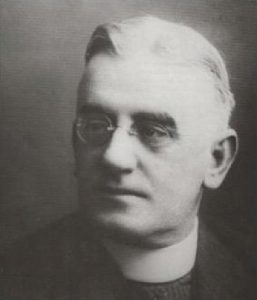
Patrick Hartigan was born in O’Connell Town, Yass (New South Wales), on 13 October 1878. His parents were Patrick Joseph Hartigan (a produce merchant) and Mary Hartigan (née Townsell), both of whom came from the village of Lisseycasey, in County Clare, Ireland.
Hartigan was interested in serving the Catholic Church and its adherents in an official capacity; he studied at St Patrick’s College in Manly (NSW), and was ordained as a priest in 1903. He then worked as a curate in Albury until 1910, when he was made an inspector of schools for Goulburn (hence his poem “The Day th’ Inspector Comes”), following which he became priest-in-charge of Berrigan in 1916, then parish priest for Narrandera in 1917, a post he held for many years.
It was in 1906 that he started to contribute poems to various magazines and newspapers, including The Bulletin, The Catholic Press, and The Albury Daily News and Wodonga Chronicle. At first he used the pen name of “Mary Ann”, but then he later changed over to the pseudonym of “John O’Brien”. Hartigan took the name of “John O’Brien” from that of a milk vendor in a country town, who had a reputation for selling adulterated milk; in 1952, recounting the tale of his nom de plume to an interviewer from The Bulletin, he stated that he had declared to himself “Adulterated milk, that’s me.” So, from a bit of humorous whimsy, the John O’Brien persona was born.
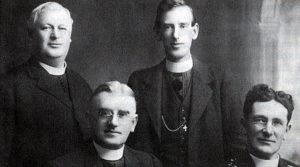
It is possible that his work as a priest may have been a contributing factor in his original decision to write his poetry under a pseudonym, thus distancing his lighter works of poetry from his more serious work as a man of the cloth. However, his secret came out, and the general public got to know that “John O’Brien” was actually a Catholic priest by the name of Patrick Hartigan.
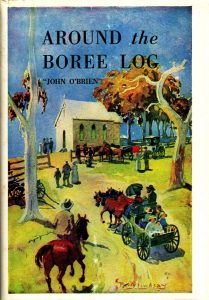
With both of Hartigan’s parents being born in Ireland (migrating in the 1860s from County Clare), his parentage is reflected in his writing. His Irish heritage shows in the usage of Irish themes in his poems, such as “The Little Irish Mother” and “St. Patrick’s Day”, as well as in his widespread use of Irish words, such as acushla, bedad, keownrawnin’, shoneen, wisha, and yerra, which appear in various of his poems.
Notwithstanding the influence of his Irish heritage, “John O’Brien” demonstrated the primacy of his feelings for Australia. In his poem “St. Patrick’s Day”, he speaks of “the hectic flush of racial pride upon St. Patrick’s Day”, but says “the love they gave their country made me conscious of my own … I see a land around me … To that big free land I’ve given all the love that courses through me … Australian — oh, the word is music to me”.
The poetry of O’Brien reflects the growth of native-born Australian culture; his Australianism is expressed in poems like “The Old Bush School”, “Could I Hear the Kookaburras Once Again”, “Ownerless”, “The Libel”, and “Come, Sing Australian Songs to Me!”
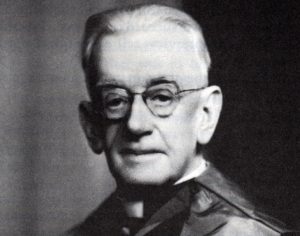
O’Brien promoted the ambience of the Australian bush in “Honeymooning from the Country”:
Scent of gum-leaves … ’Tis the finest scent on earth.
Ay, it clung around the Anzacs when they stormed Gallipoli;
And it steeps the nation-builders from the centre to the sea.
Speed the day when all united, heart to heart and hand to hand,
We’ll proclaim the scent of gum-leaves to be sacred in the land.
Writing at a time when there was a large foreign influence upon cultural entertainment in Australia, O’Brien bemoaned the lack of Australian music, or its lack of predominance. In “Come, Sing Australian Songs to Me!” he called for an upsurge in Australian music:
You sing the songs of all the earth,
Of alien flower and alien tree:
But no one, in my grief or mirth,
Will sing Australian songs to me. …
Ah, Little One, what dreams would rise
If, nestled here upon my knee,
You’d flash those soft Australian eyes,
And sing your country’s songs to me!
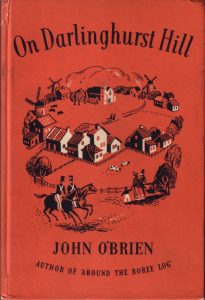
He became severely ill in 1952, and was admitted to hospital, staying there for several months. Patrick Hartigan died in Lewisham Hospital (Lewisham, NSW), on 27 December 1952.
However, despite his passing, his literary legacy continued on, as his nephew, Father F.A. Mecham, collected his later verse, leading to the posthumous publication of a second book of his poetry in 1954, The Parish of St Mel’s and Other Verses. In 1975 another book by “John O’Brien” was published, The Men of ’38 and Other Pioneer Priests, consisting of his articles which were originally published in the Australian Catholic Record (from 1943 to 1945).
Lest he be forgotten, his memory is celebrated by an annual bush festival. The town of Narrandera, where Patrick Hartigan served as parish priest for many years, has hosted a John O’Brien Bush Festival since 1994. The festival celebrates Australian rural culture, puts on performances of the poetry of John O’Brien, as well as hosting a roll-up of modern bush poets; it also encourages musical works, with solo and band performances, a bush dance, and a busking competition, along with various other events and activities.
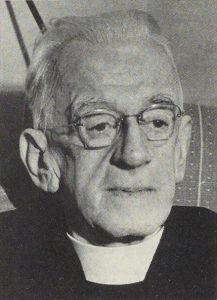
Whilst there was an Irish tint to some of his poems, O’Brien went beyond the bounds of his parental Irish roots, and promoted an Australianism which he had grown into as a product of his environment.
Patrick Hartigan, as John O’Brien, made a significant contribution to Australian literature, one which is worthwhile celebrating. As The Cairns Post once said, “John O’Brien bears an honoured place on the scroll of Australia’s most popular versifiers”.
Books and other works by John O’Brien:
Works of John O’Brien
Articles about John O’Brien:
[Personal Items: Father Patrick Joseph Hartigan] [12 November 1947]
Father Patrick Joseph Hartigan made a Monsignor by the Catholic Church.
[Personal Items: Monsignor Hartigan] [28 May 1952]
A brief report of an interview by The Bulletin with Monsignor Patrick Hartigan (includes the origin of the pseudonym “John O’Brien”).
“Around the Boree Log”: Death of author [31 December 1952]
A brief obituary for Monsignor Patrick Hartigan.
Literary Nook: “The Parish of St. Mel’s” [10 July 1954]
A review of The Parish of St Mel’s and Other Verses.
References:
G. P. Walsh. “Hartigan, Patrick Joseph (1878–1952) ”, Australian Dictionary of Biography, National Centre of Biography, Australian National University
“Personal items”, The Bulletin, 28 May 1952, p. 23 (columns 4-5) (re. the origin of the pseudonym “John O’Brien”)
““Around the Boree Log”: Death of author”, The Charleville Times (Charleville, Qld.), 31 December 1952, p. 5 (re. 100,000 books)
““Boree Log” author dies”, The Sunday Herald (Sydney, NSW), 28 December 1952, p. 3 (Sunday edition of The Sydney Morning Herald) (re. 100,000 books)
“Death of last of “the bush balladists””, The West Australian (Perth, WA), 29 December 1952, p. 2 (re. illness, hospital; 100,000 books)
“Literary nook: The Parish of St. Mel’s”, The Cairns Post (Cairns, Qld.), 10 July 1954, p. 4 (re. 82,000 books, “an honoured place”)
“John O’Brien Bush Festival”, Narrandera Visitor Information Centre (Narrandera Shire Council)
“John O’Brien Bush Festival in Narrandera”, Western Riverina Arts
Further reading:
“Patrick Joseph Hartigan”, Wikipedia
“John O’Brien Commemorative Wall”, VisitNSW.com (Destination NSW)
My late father ,”Jack” O’Brien (d.1954) lived in Griffith and knew Father Hartigan well. Father gave him a copy of the Poems centred around St Mel’s in Narrandera. Not sure who in my family has that tome. I was taught by the Sisters of Mercy at St Lawrence’s Galong (NSW) in the later 1950’s and we often recited his poems in class.
Reading his poems brings tears to my eyes as I remember the beauty of his pose .
My uncle Desmond Lane was a curate at Narrandera after Patrick Hartigan and told us stories about him in his old age – no doubt at St Mels
My Great, Great, great Grandfather was John Casey from Loughmore, Ireland (convict) – “Casey’s after Mass” appears to be about his family including his wife Caroline – their daughter Mary – (married into the Reid family) – Before he settled in Gundaroo John helped to capture the bushranger Tenant & was granted his “ticket of leave”…..if only I could find other photos of them!
There is a photo of John Casey and his second wife, Caroline Purcell, on Wikipedia, at: https://en.wikipedia.org/wiki/John_Casey_(Australian_convict)
John Casey and his wife also receive a mention in the “Christians of the Australian Clay” blog, which says they were “early practitioners of ‘the Roughly Christian’ “Open House” in a life embracing a Christian Ethic of Generosity, Neighbourliness and Hospitality.”
(The rest of the entry is taken from the Wikipedia page.)
http://australiansaints.blogspot.com/2011/09/b-c-d-surname-list.html
I may possibly have a signed copy of Around the Boree Log from 1926. Would anyone know where I could view a copy of his signature?